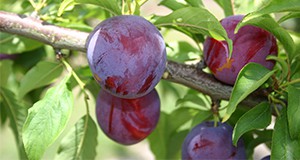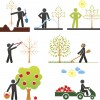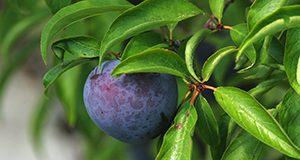Las ciruelas podrían ser un cultivo potencial para los productores y propietarios de viviendas en Florida y otras áreas de invierno templado en toda la costa del Golfo, pero muchas variedades de ciruelas de la costa oeste no funcionarán de manera consistente en Florida para producir fruta. Sin embargo, el programa de mejoramiento de fruta de hueso de la Universidad de Florida ha desarrollado cultivares que mejoran el potencial para el cultivo de ciruelas en Florida y otras áreas de invierno templado que tienen alta presión de enfermedades. Estos cultivares se recomiendan para probar en Florida. Los nombres de todos los cultivares de ciruela de la Universidad de Florida comienzan con el prefijo 'Gulf'. Estos cultivares son ciruelas de tipo japonés (Prunus salicina Lindl.) y tienen resistencia al escaldado de hojas de ciruela (Xylella fastidiosa) y a la bacteriosis o cribado (Xanthomonas campestris). El tamaño del fruto es satisfactorio (aproximadamente 1½ a 2 pulgadas de diámetro) con buena calidad del fruto. Maduran a principios o finales de mayo, aproximadamente dos semanas antes de que las ciruelas de otras áreas lleguen al Mercado.
This new 14-page fact sheet is the Spanish translation of HS895/HS250, Growing Plums in Florida, written by A. Sarkhosh, M. Olmstead, E. P. Miller, P. C. Andersen, and J. G. Williamson, translated by Tatiana Sanchez, and published by the UF/IFAS Horticultural Sciences Department.
https://edis.ifas.ufl.edu/hs1364
Tag: P. C. Andersen
Growing Plums in Florida

Plums could be a potential crop for growers and homeowners in Florida and other mild winter areas throughout the Gulf coast, but many plum varieties will not grow well enough in Florida to produce fruit. In response to this need, the University of Florida has developed cultivars that improve the potential for growing plums in Florida. This twelve-page fact sheet provides information for growing plums in Florida including information about chilling hours, pollination and fruit set, fruit harvesting, yields, as well as information about the plum cultivars adapted to grow in Florida. Written by M. Olmstead, E.P. Miller, P.C. Andersen, and J.G. Williamson, and published by the Horticultural Sciences Department.
http://edis.ifas.ufl.edu/hs250
Florida Peach and Nectarine Varieties
 The University of Florida has developed high-quality, low-chilling, early-maturing peach and nectarine cultivars that can be grown from the panhandle of Florida to as far south as Immokalee. Low-chilling cultivars can grow and produce fruit under Florida conditions that are much warmer in winter than in northern states. Furthermore, ripening of these cultivars during April and May ensures an early spring market window for tree-ripe fresh fruit in Florida before peaches and nectarines from other southeastern states and California come to market. Both commercial and dooryard recommended varieties span the growing season. This 8-page fact sheet was written by Mercy Olmstead, Jose Chaparro, Pete Andersen, Jeff Williamson, and James Ferguson, and published by the UF Department of Horticultural Sciences, May 2013.
The University of Florida has developed high-quality, low-chilling, early-maturing peach and nectarine cultivars that can be grown from the panhandle of Florida to as far south as Immokalee. Low-chilling cultivars can grow and produce fruit under Florida conditions that are much warmer in winter than in northern states. Furthermore, ripening of these cultivars during April and May ensures an early spring market window for tree-ripe fresh fruit in Florida before peaches and nectarines from other southeastern states and California come to market. Both commercial and dooryard recommended varieties span the growing season. This 8-page fact sheet was written by Mercy Olmstead, Jose Chaparro, Pete Andersen, Jeff Williamson, and James Ferguson, and published by the UF Department of Horticultural Sciences, May 2013.
http://edis.ifas.ufl.edu/mg374
Directory of Certified Deciduous Fruit and Nut Crops in Florida
 This 8-page fact sheet written by experts at North Florida REC Peter C. Andersen, Robert C. Hochmuth, Sean R. McCoy, and Lei Lani L. Davis, assists farmers in locating recommended cultivars of fruit and nut crops from Florida nurseries. The nurseries listed in Table 1 offer fruit and nut trees and are listed as certified nurseries with the Florida Department of Agriculture and Consumer Services. Table 2 lists fruit and nut cultivars that UF/IFAS Extension specialists currently recommend or suggest on a trial basis. Published by the UF Department of Horticultural Sciences, April 2013.
This 8-page fact sheet written by experts at North Florida REC Peter C. Andersen, Robert C. Hochmuth, Sean R. McCoy, and Lei Lani L. Davis, assists farmers in locating recommended cultivars of fruit and nut crops from Florida nurseries. The nurseries listed in Table 1 offer fruit and nut trees and are listed as certified nurseries with the Florida Department of Agriculture and Consumer Services. Table 2 lists fruit and nut cultivars that UF/IFAS Extension specialists currently recommend or suggest on a trial basis. Published by the UF Department of Horticultural Sciences, April 2013.
http://edis.ifas.ufl.edu/hs1218
Pecan Cultivars for North Florida (HS106)
 Pecan recommendations for Florida have been updated to include new information about cultivar performance. Check out this 13-page fact sheet to select the best cultivars for yield, performance, resistance to disease, and resistance to limb breakage. Written by Peter C. Andersen, and published by the UF Department of Horticultural Sciences, September 2011. (UF/IFAS Photo: Thomas Wright.)
Pecan recommendations for Florida have been updated to include new information about cultivar performance. Check out this 13-page fact sheet to select the best cultivars for yield, performance, resistance to disease, and resistance to limb breakage. Written by Peter C. Andersen, and published by the UF Department of Horticultural Sciences, September 2011. (UF/IFAS Photo: Thomas Wright.)
http://edis.ifas.ufl.edu/hs106
The Blackberry (HS807/HS104)
Learn about traditional and promising new cultivars and how to grow them the home landscape. This 10-page fact sheet was written by Peter C. Andersen and Timothy E. Crocker, and published by the UF Department of Horticultural Sciences, May 2011.
http://edis.ifas.ufl.edu/hs104
HS27/MG214 The Fig
Revised! HS-27, a 5-page fact sheet by Peter C. Andersen and Timothy E. Crocker, provides the history of fig cultivation, adaptation, description of the fig tree, its culture and management, pests, and fig cultivars. Published by the UF Department of Horticultural Sciences, November 2009.
http://edis.ifas.ufl.edu/mg214
HS765/MG367 Sustainability Assessment of Fruit and Nut Crops in North Florida and North Central Florida
Revised! HS-765, an 18-page illustrated article by Peter C. Andersen, Jeffrey G. Williamson, and Timothy E. Crocker, summarizes the degree of adaptation of deciduous fruit and nut species in Florida and identifies cultivars that are recommended for trial in various locations in Florida. Includes references. Published by the UF Department of Horticultural Sciences, September 2009.
http://edis.ifas.ufl.edu/MG367
HS764/MG368 Low Chill Apple Cultivars for North Florida and North Central Florida
Revised! HS-764, a 10-page fact sheet by Peter C. Andersen and Timothy E. Crocker, provides guidance for homeowners in north and north central Florida to grow apple cultivars with low chilling requirement — how to locate them for best performance, suitable cultivars, acceptable rootstocks, planting, cultivation, fertilization, irrigation, training and pruning, harvesting and storage, and pest control. Includes references. Published by the UF Department of Horticultural Sciences, August 2009.
http://edis.ifas.ufl.edu/MG368
CIR1221/MG366 Deciduous Fruit for the Home Garden in Central Florida
Revised! Circular 1221, an 18-page ullustrated circular by T. E. Crocker, A. J. Rose, J.G. Williamson and P.C. Andersen, describes the various types of orchard fruits, their suitability to the Florida home orchard, and the process involved in raising a home orchard. Includes references. Published by the UF Department of Horticultural Sciences, May 2009.
http://edis.ifas.ufl.edu/MG366
HS1152/HS401 Commercial Fresh Market, Wine, Juice, and Jelly Grape Cultivars for Florida, 2008
HS-1152, a 4-page illustrated fact sheet by J. Breman and P. C. Andersen, describes the characteristics needed in cultivars for successful commercial grape production in Florida. Includes references and information on cultivars recommended by IFAS for wine, juice and jelly, and fresh market, plus fresh-market muscadine cultivars for planting on a trial basis, and sensory evaluation results. Published by the UF Department of Horticultural Sciences, November 2008.
http://edis.ifas.ufl.edu/HS401
